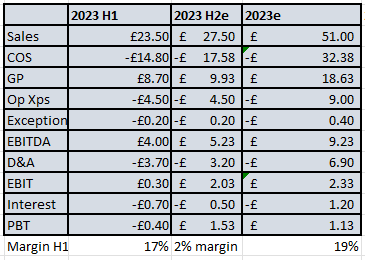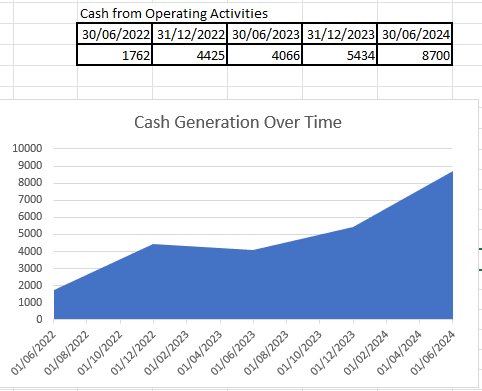Dear reader
I covered VLG back in the murky mists of Sep 2023 in my article “Should you put a Cap in it?”
In that article I argued that Cavendish were being too pessimistic and there would be a higher out turn in H2 2023. Who was right?
We only have the Trading Statement and not the Full Year Results, but piecing together the numbers it appears the out turn is a slight beat to Cavendish’s estimates but below my own (£51m vs £53.9m revenue and £9.2m EBITDA vs £10.5m).
We know the sales figures, and we know that EBITDA margin has improved by 2%. We know that H1 was 17% margin so I take H2 to be 19% margin. Working backwards I assume Op Xps to be static, and for the difference to be COS (cost of sales).
What emerges is a good set of numbers, for what is a £50m market cap, on a 2023 PE of 16.6, but what of 2024 and beyond? Let’s start in the past and then speak to the future.
VLG was a covid share play in its heydey pioneering heady heights reaching 90p-£1 a share which I remember Simon Thompson believed would fly higher. Dentyl which could protect you from Covid, hand gel for killing that pesky virus, enabling virus-free clapping of a Thursday eve, nodding satisfactorily to neighbours left and right and across, critiquing their leisure-ware options. VLG was busily planning on penetrating China where the demand for such products would be without any end.
And then the world and his wife “helped out” making hand gel. Gin makers, beer makers - they were all making hand gel. From paying top dollar for covid protection all of a sudden a band wagon led to a glut. Meanwhile the China penetration was, err, non-penetrating (and 3 years later appears to remain so).
The share price crashed. Thompson has never spoke of VLG since.
Interestingly, for this plucky AIM-listed healthcare company based in Berkshire and Italy and Sweden, as well as Dentyl, it had raised funds (and arranged debt) which it used to acquire several brands of Women’s intimate health products, Oncology Care products, and all those kinds of things you slip into your shopping basket to treat various embarrassing maladies.
Today, just over 2 years later, and after a further acquisition buying Earol (an ear wax treatment), in December 2022, the business sits with a highly defensive portfolio of products. Some of these are in a highly competitive space. Dentyl particularly competes against the 3 giants Colgate-Palmolive, Johnson & Johnson and GSK (now Haleon), yet Dentyl appears quite often on supermarket shelves. In my opinion it is the least “antiseptic” of mouthwashes and uses “oil pulling” as part of its strategy to clean your mouth and throat (where Covid begins its infection).
Other products are less competitive and I’d be very surprised if a single one of my readers knows the competitive prices for Proctology products - if you need it you don’t care about the price, I would imagine.
For people with various skin complaints, it’s much the same. Rosacea, fungus fingers, you want a fix - asap. You are probably a repeat buyer too.
Anyway I could list all the products but you get the idea. Healthcare, defensive, repeat purchase, brand loyalty with growing needs.
What particularly excited me reader was something I read in the Trading Update. Debt to Earnings falling from 1.25X and 1.1X post period. Well, post period is 1 month (January). Doing some calcs, using my Adjusted EBTIDA estimate, that tid bit tells me VLG generated about £1.45m of cash from operations in January. Price changes late 2023 are now kicking in and boosting profitability (and cash)
Annualised that’s £17.4m cash from ops, or double the £9.5m achieved the year before. In fact we can see cash generative growth over several years.
Lots of encouraging points in the trading update around product sales growth too:
28 new product launches (VLG have a product development centre for customer brands and own brands)
Lift (Diabetes support) up +20% YoY
Gelclair (Oncology support) +52% YoY
Digital Channel Sales +40% YoY
Balance Activ Thrush Cream exceeded target; newly developed product confirmed with major UK retailer
What impresses me with VLG is the level of passion and commitment that appear to come from the product managers and people on the coal face. This is a link to their June 2023 Capital Markets day - a 2 hour 47 mins presentation, but you come away impressed - least I did. The improved H2 results are a testament to their hard work.
IIs like Slater Investments like VLG too. Having held for several years it’s interesting to see the smart money recently accumulating larger positions here too.
Looking at their assets, 2 factories and current assets back up 80% of the market cap, and on a tangible net assets balances to a net of about zero. However, those factories are at about 50% capacity so growth helps spread fixed costs thinner and wouldn’t involve expensive expansion.
Meanwhile, intangible assets of around £75m (goodwill and product development) take this to 1.5X the market cap (£50m). So the question is the extent to which you value the products and brand equity. This is a difficult one to answer because on one hand brand recall would probably be quite low (I am picturing the chap from the Pointless Quiz show asking about Brands of Ear Wax softening!) but then again, if you’ve suffered from ear pain (as many have) then you may “swear by Earol”. Many products are repeat purchase too. Dentyl, the women’s health products - these aren’t one off purchases, so the value to my mind isn’t zero. The fact that VLG products regularly achieve shelf space in retailers is an intangible too - not easy to get that space if you don’t have it.
Ear wax is a great example actually. The NHS used to provide treatment like wax suction. They now don’t (except in exceptional circumstances). If you go to hospital due to ear pain the triage nurse may look in your ear and tell you to go shopping. If you’ve narrow ear canals you are wise to do daily dose of ear wax softening so the demand for Earol is actually substantial and growing - and that’s just in the UK. VLG sell into dozens of countries via distributors.
At the risk of being fanciful, but being acquired is a real possibility. For another of my holdings, Supreme, I can picture VLG being a tasty asset to buy up, let alone for the large health product giants - P&G, Colgate, Haleon, J&J, Unilever etc.
OB vs Cavendish the requiem
I produced my own estimates for 2024 and then compared to theirs. Perhaps unsurprisingly, I am more optimistic than Cavendish. What baffles me though is their 2024 revenue estimate is £55m which eagle-eyed readers will see means Cavendish are assuming ZERO revenue growth in 2024 (compared to H2 23). Really? Did we read the same trading statement? 28 new products, high levels of growth? January leverage dropping by nearly £1.5m? I assume a 9% revenue growth this year, and I don’t think that it particularly optimistic (in fact H1 to H2 there is 17% revenue growth so I’m saying it will slow by 50% and Cavendish think it will slow by 100%). I also believe COS as a percentage of revenue will fall due to an (estimated) 5% improvement on margin (due to the announced price rises Q4 23). A 5% rise feels reasonable given the inflation environment of 2023, which given the rising margin hasn’t squeezed VLG into increasing its prices.
So Cavendish believe £4.8m adj.PBT vs my £8.4m estimate. Our difference is around the sales delta above, but also interest payments. I believe the debt will be close to zero by the second half and interest turns to an income later in H2 leading to a net zero cost - whereas Cavendish believe VLG will pay £1.6m interest in 2024 on a debt balance which has dropped from £12m to about £10.6m in a month. By my estimation VLG would need to pay well in excess of 20% interest to pay that much in 2024 - or they are they are far less optimistic about VLG’s cash generation capability going forwards paying down debt despite it being a strong feature over multiple years - and appear to accelerate in January. My graph clearly shows the passage of travel.
Well, whoever is correct, or if it’s between the two (like this year) what I would draw your attention to reader is the profit growth.
Profits forecast to grow from £1.1m to either £4.8m or £8.4m is a company worthy of some contemplation. Valuing this at an undemanding 15X multiple (remember this is a defensive share) and assuming forward earnings 2025 and beyond are static (!), this puts VLG on a 2.5X upside (which puts it at a target price of about £1.00). And if this article has given you an itch to read more, and not to scratch the idea; VLG has probably already got the remedy!

This is not advice.
Oak













I've been asked some questions by a reader:
Q1 "I enjoyed your article but I think VLG offers materially better value than your article suggests. Cavendish’s latest estimates show adjusted eps of 5.4p for FY 23 and 6.4p for FY 24 which equates to PEs of only 7.2 and 6.1 using a share price of 39p. This is materially lower than than the 15 quoted in your article!!"
--> If you do the maths Cavendish think "adj. EPS" (not EPS using net income) is 5.4p in FY23. Multiplied by the number of shares that's earnings of £6.8m. Which doesn't tally to their adj. EBITDA?!
-->15X was what I consider a fair valuation approach i.e. a 15 times multiple. Sorry if that wasn't clear. My own EPS (based on actual NET income not adjusted) is 0.1p in FY23 and grows to 6.6p in FY24. So a FY24 forecast PE of 5.9 - but that's PBT. Not an adjusted EBITDA
Q2 "Note VLG has been a buy and build story and so there is a lot of goodwill from acquisitions (much of which was allocated to the brands acquired), this results in a a chunk of intangible ( goodwill & acquired brands) amortisation going through the P&L. It is standard for all companies to add this back when calculating adjusted eps."
--> I don't disagree.
"I would also highlight the very high free cash flow forecasts ( after capex, tax and interest payments) generated by the business. Based on Cavendish forecasts free cash flow is £6.8m for FY23 and £8m for FY 24 . This is a free cash flow yield of 13.8% and 16.3% respectively based on a current share price of 39p."
--> You are right to highlight those forecasts. While the fruit has taken a few years to mature, the share price is barely ahead of when it was struggling with chronic oversupply of one of its (then) core products. The FCF profile has substantially changed as my article hopefully also highlights, and the market hasn't yet recognised this (in the price).
Intersting company , bought some shares after looking into it , and fits my preference for fmcg companies; With regards to being bought by Supreme, I think there are areas which would be a nice fit. VLG could team up with Supreme to get their Dentyl business going which is lagging although there seems to be some uniqueness/differentiatiin to the brand.Lyft is another option which would benefit from broader distribution capabilities.
Anyway beeing a fan of Supreme and before stumbling over VLG i thought there would be some logic if Supreme ventured into the OTC medicine Space , exploring adjacencies to their wellness products or even adding new categories to their portfolio.